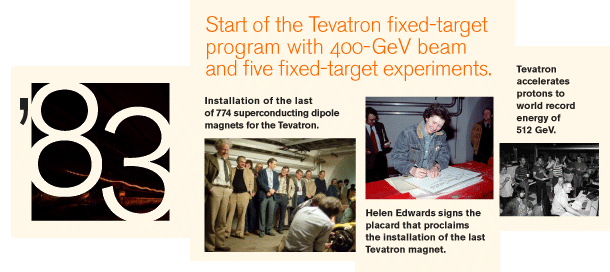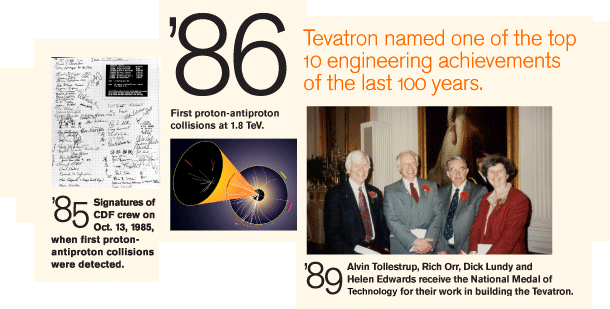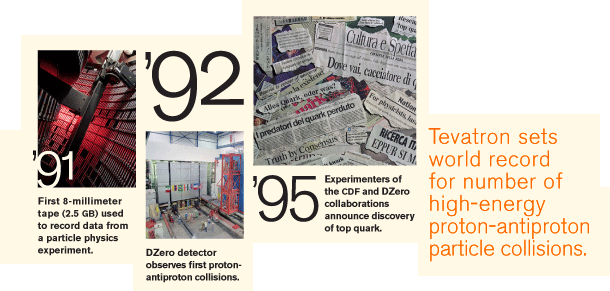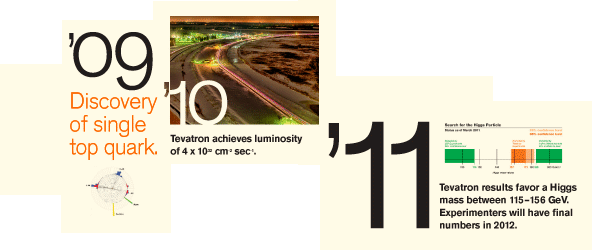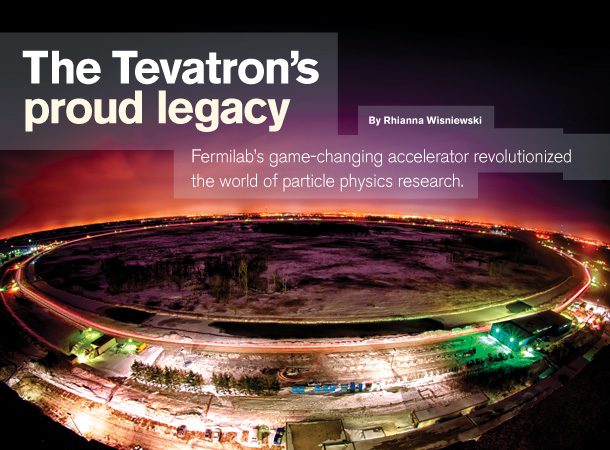
Printed version
Related content
- Dedicated Tevatron celebration website
- Interactive time line
- Tevatron shutdown talks (video)
- The Tevatron's result of the week
- Logbook: First Tevatron collision
- 60 seconds: Particle accelerators
- Tevatron's contribution to developing MRI machines
- Colliding beam in Tevatron tunnel (animation)
- Fermilab's plan for the future
The Tevatron's proud legacy
Fermilab's game-changing accelerator revolutionized the world of particle physics research.
By Rhianna Wisniewski
Just after 2:30 p.m. on Sept. 30, Fermilab accelerator pioneer Helen Edwards prepared to stop the circulation of subatomic particles in the Tevatron collider for the last time. She was a fitting choice; Edwards and her husband, Don, had led the Tevatron start-up nearly three decades earlier. Now she would lay the massive collider to rest.
She pushed the button to dump the beam. Nothing happened.
The Tevatron--for years the most powerful particle collider on Earth--wasn't going to go quietly.
Laughter eased the tension for several hundred people watching the event on screens in Fermilab's main auditorium a hundred yards away. Edwards' second try succeeded, and the scientists who had gathered at the lab for the occasion took an afternoon to reflect on this remarkable machine.
"Physicists here took the Tevatron I got to help build and improved it and continued to do physics far beyond what it was originally designed for," says Rich Andrews, a mechanical engineer at Fermilab. "In many ways, it changed the worldnot just with physics, but also with the technology that came out of it."
For 28 years, between 1983 and 2011, scientists at the Tevatron used its beams of subatomic particles to gain a better understanding of matter, energy, space, and time. Their experiments revealed many new particles, most famously the top quark, and yielded countless achievements in detector, accelerator, and computing technology.
What began as a revolutionary idea in the early 1970s grew into one of the most successful physics programs of all time, a testament to the dedication, creativity, and indomitable spirit of thousands of people at Fermilab who made it happen over the years. Their innovation and stubborn determination made possible the success of the Tevatron's design and commissioning, its subsequent upgrades, and the impressive legacy it leaves behind.
The first of its kind
The idea for the superconducting accelerator that eventually became the Tevatron emerged in the early 1970s as the brainchild of Robert Wilson, Fermilab's founding director. The laboratory was just cutting its teeth on its first accelerator, the Main Ring, a machine that used conventional non-superconducting technology to send beams of particles to experiments at an array of fixed targets.
"The Main Ring had a lot of setbacks, and there were plenty of people who didn't think that the Tevatron would work," says John Crawford, former deputy head of the accelerator Operations Department.
But Wilson, undeterred, forged ahead with the Energy Doubler, the Tevatron's original name, conferred because it would double the energy of the Main Ring.
"Bob Wilson and the people around him embodied this attitude: Try new things," says Bob Mau, retired head of the accelerator Operations Department. "I had a guy in my group who came up with really crazy ideas, but I never dismissed them. Fifty percent of the time the ideas were brilliant. The other 50 percent were just nuts."
Wilson proposed to build the Tevatron in the same tunnel as the Main Ring, beneath its ring of magnets in space reserved during Main Ring construction with an eye toward a future accelerator. As proposed, the new machine would generate twice the magnetic field and beam energy of the Main Ring. While it would power some fixed-target experiments, ultimately it would also guide particles into head-on collisions with total energies of 1.8 trillion to 2 trillion electronvolts, or TeV--whence the name Tevatron. Its higher energies would open whole new regions of physics for scientific exploration. The plan included an antiproton storage ring, which became the most intense, consistent source of antiprotons in the world.
While the ideas were exciting, execution posed enormous challenges. What magnetic field would be required to hold orbiting proton beams in the machine so they could collide over long periods? Where would the accelerator builders locate unprecedented quantities of superconducting wire and cable? Could they produce working magnets on a large scale? Building the world's first large-scale superconducting magnet system, along with the cryogenic system to cool it to temperatures near absolute zero, wouldn't be easy.
As efforts to get the Tevatron on track ramped up in the late 1970s, physicist Leon Lederman, who succeeded Wilson as Fermilab's director in 1979, worked to bring the laboratory together in pursuit of a common goal: Build the Tevatron and make it work. People began to work around the clock, sometimes sleeping at the office, to complete the project.
"We did whatever it took to get the job done, across work groups and departments," says Fermilab engineer Paul Czarapata. "We had a lot of cooperation. When the day's work called for a cable pull, everyone would lend a hand."
Don and Helen Edwards led five commissioning teams, each in charge of a different area. Mau served on Don Edwards' team.
"It was great to see the constant interaction of brilliant people," Mau says. "To be able to sit in the middle of that was amazing."
At 3:37 p.m. on Sunday, July 3, 1983, the Energy Doubler accelerated protons to a world record of 512 GeV. Those on shift and others nearby filled the Main Control Room to cheer and sip champagne.
At first, the Tevatron operated as a fixed-target accelerator. Then, in 1985, with the completion of the Antiproton Source, collider operations began, with the world's highest-energy proton-antiproton collisions. The CDF experiment recorded the first collisions in 1985; DZero began operations seven years later.
Onward and upward
Once the Tevatron was up and running, it wasn't the end of the story. In fact it was just the beginning.
"The Tevatron of 2011 was not the original Tevatron," Czarapata says. "It represented the evolution of ideas and a labor of love. It worked because of people who had intense pride in their systems. That's why, if the Booster went down, we'd see people in here at 3 a.m.because it was their machine."
Superconducting magnets must operate at temperatures near absolute zero. Anything--movement from a loose cable, for example--that raises the temperature in even a tiny volume of the superconductor inside a magnet can cause the superconductor to quench, or switch to a normal conducting state. A quench forces the power system to rapidly extract the energy stored in the magnetic field of the magnet and remove the beam from the machine. Needless to say, this unreliability affected the amount of physics that the Tevatron could do. During early operation of the Tevatron this sort of thing happened frequently--every day during some periods of running--and caused some to think, once more, that the machine was doomed. But Tevatron experts tackled each problem as it arose, and gradually the Tevatron began to run smoothly and reliably.
Early in the development of the Tevatron, Sharon Lackey joined the team with the job of designing the quench protection monitor for a set of special magnets at the experimental areas. She would occasionally help operators determine what action to take before turning the magnets back on after a quench.
"I really enjoyed the problem solvinggetting something to work," she says. "It was the puzzle to figure something out, work on it, break things, and then get through the drudgery until you got a breakthrough. The process was kind of addictive."
By the mid-1990s, the Tevatron was running smoothly and discoveries were pouring in. Scientists were creating particle collisions at record energies, and the two detectors, CDF and DZero, were shining a bright light on the fundamental building blocks of the universe. In 1995, Fermilab scientists announced the discovery of the top quark, a key missing piece of the Standard Model of particle physics.
Fermilab leaders realized, though, that upgrades to the Tevatron complex could reveal still more. This would require changes in both the accelerator and the detectors aimed at increasing luminosity, a measure of the number of particle collisions that occur each second. The more particle collisions per second, the better the chances for discovery.
"When you build a machine, you don't just build it. Every year, you improve it. You make it more robust, raise the intensity of the beam, and you make beams collide instead of just aiming them at a fixed target," Andrews explains.
The laboratory set about making upgrades for the Tevatron's second scientific run and beyond. The most ambitious improvement, the Main Injector, was a new accelerator tangential to the Tevatron. It provided a better way of accelerating protons and antiprotons before injecting them into the Tevatron. Other upgrades occurred throughout the accelerator complex. By the time the Tevatron was shut down, it had achieved peak luminosities that exceeded 4x1032 cm-2 sec-1, or 400 times the design specification of the original machine.
Each detector collaboration also added new systems that vastly improved their physics potential. The CDF collaboration installed a secondary vertex trigger, the brainchild of scientist Luciano Ristori.
"This had never been done before," says Rob Roser, former co-spokesperson for Fermilab's CDF collaboration.
A trigger is a system that examines every particle collision of the millions that occur each second to determine, based on pre-loaded criteria, whether the collision has produced particles of interest and should be recorded for analysis. The vertex trigger looked specifically for collisions producing bottom quarks. Identifying and measuring these particles can help physicists detect some of the most hard-to-see particles theorized in high-energy physics, such as the Higgs boson, the particle that scientists believe gives mass to all other particles.
Upgrades at CDF also included an innovative new trigger that allowed physicists to select collision events to record while continuing to record incoming data.
DZero's muon system was another innovative upgrade. Collaboration co-spokesperson Dmitri Denisov led the upgrade for the system, which allows scientists to see and measure the entire particle interaction region in the detector, with no blind spots--a milestone in detector physics.
Arguably the most significant improvements made to the accelerator complex were a new storage ring for antiprotons and the implementation of a new system to cool, or condense, the particles in a beam to maximize the chances of collision. This system used electrons to cool the beam, allowing the accelerator complex to collect antiprotons at a higher rate and accelerate a denser beam, translating to significantly more collisions.
Russian-born scientists Sergei Nagaitsev and Sasha Shemyakin spent 10 years working with a small team designing, testing, and implementing the electron cooling system. Nagaitsev knew that the technology existed, but wasn't sure how to make it work at the high energies necessary for the Tevatron.
Nagaitsev, who led the effort, attributes the system's success to determination and hard work, but also to intuition and a lot of trial and error.
When electron cooling was implemented at Fermilab in 2005, scientists thought it could help increase the peak luminosity by a factor of 1.5 to 2. In fact, it became integral to the Tevatron's success, leading to an increase in peak luminosity by nearly a factor of three.
"The successful implementation of electron cooling has had a larger effect on the luminosity of the Tevatron than any other single improvement," says Accelerator Division head Roger Dixon.
Leaving a legacy
Fermilab's Tevatron builders began creating a legacy of technological advances long before the machine started up.
In order to build the Tevatron, the laboratory had to produce nearly a thousand superconducting magnets. To do that required procuring unprecedented quantities of superconducting wire and cable, a move that eventually helped pave the way for the development of magnetic resonance imaging, or MRI, for medical diagnostics.
"One of the biggest legacies is that we built the superconducting industry when we built the Tevatron," Fermilab physicist Jim Lackey says.
In the words of the late Robert Marsh, former CEO of what is now Oregon's ATI Wah Chang, still the world's largest supplier of superconducting alloys, "Every program in superconductivity that there is today owes itself in some measure to the fact that Fermilab built the Tevatron and it worked."
Technology created for accelerators such as the Tevatron also spurred the commercial use of particle accelerators. An estimated 30,000 accelerators around the world are at work in medicine and industry to treat cancer, harden materials, and scan cargo, among myriad other applications.
The components built for and perfected at Tevatron experiments are also at work in detectors all over the world. The Tevatron experiments developed and refined technologies used at accelerators such as RHIC at Brookhaven, HERA at the German laboratory DESY and the two main detectors at CERN's Large Hadron Collider, ATLAS and CMS.
"CMS looks an awful lot like CDF," Roser says.
The silicon detectors that track the paths of particles emerging from collisions in the CMS and ATLAS experiments are based on those in the Fermilab CDF and DZero detectors.
"No one thought that the silicon trackers would work in hadron colliders," Roser says. "But they work really well. CDF showed that this was possible and now there isn't an experiment out there that doesn't have one."
Even though the Tevatron's CDF and DZero detectors have stopped collecting data, researchers will continue to sift through the mountain of data collected while the accelerator was running, looking for signs of the Higgs boson and other new physics.
The Standard Model, says Denisov, is the true legacy the Tevatron is leaving behind. It is basically complete, he says.
"We've verified with very high accuracy the Standard Model and made it as solid as it can be. It might change, but in the area where it is applicable, it will never be wrong," he says.
“The Tevatron is the particle physics equivalent of landing on the moon.”
Dmitri Denisov
Working at the Tevatron has also taught hundreds of talented people how to handle giant scientific projects and collaborations.
"We have staff members here who are almost unique in the world. They have the capability to design and build an accelerator and the knowledge to make that accelerator operate," says Steve Holmes, project manager for Fermilab's proposed Project X. "They are an extraordinary talent pool."
Mary Convery and Consolato Gattuso, who shared coordination of the day-to-day running of the Tevatron complex, say the training they got was like working in a hospital emergency room. Not a routine day went by.
"Being run coordinator, you see the whole puzzle. This is a logical, analytical job. You're faced with challenges and problems and you have to figure out solutions," Convery explains. "Without a crisis to resolve, there isn't a sense of accomplishment."
The experience of running a big collideror building one from scratchis invaluable. It was the dedication and the unconventional thinking encouraged at the lab that allowed people and their careers to continue to grow.
"A lot of employees didn't have fancy titles, but they made their way up in the organization because they showed they could do the job," Mau says.
In addition to Fermilab's staff members, thousands of young graduate students received their training on the Tevatron.
"There's a whole generation of particle physicists who got their training here," Denisov says. "They're part of a scientific culture, the US culture of openness and independence. Without the Tevatron, none of these things would be possible."
Jim Lackey thinks that's an often-overlooked aspect of basic research.
"The young graduate students in physics are doing research here and training as the researchers of the future," he says. "These are the people who will go out and teach our kids, who will pass on to our kids the love of learning."
The Tevatron's remarkable legacy also includes a foundation for the future. Fermilab's future experiments and projects will recycle and reuse some of the Tevatron's equipment. And none of the current or future projects would be possible without the technologies pioneered at the country's premier accelerator.
"The Tevatron is the particle physics equivalent of landing on the moon. We achieved something that, scientifically and technically, wasn't possible before," DZero's Denisov says. "Now it's time to take the next steps."



